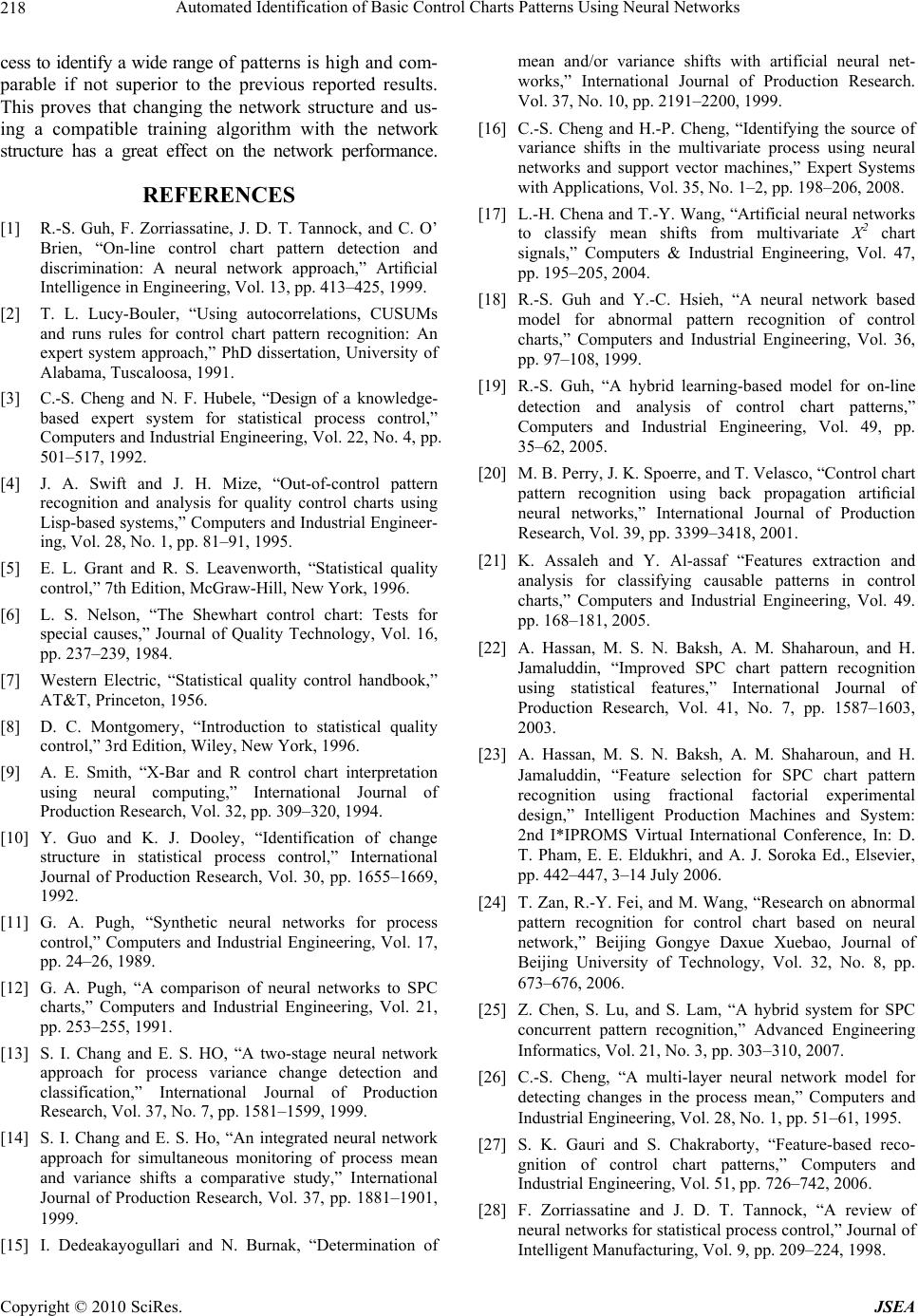
Automated Identification of Basic Control Charts Patterns Using Neural Networks
218
cess to identify a wide range of patterns is high and com-
parable if not superior to the previous reported results.
This proves that changing the network structure and us-
ing a compatible training algorithm with the network
structure has a great effect on the network performance.
REFERENCES
[1] R.-S. Guh, F. Zorriassatine, J. D. T. Tannock, and C. O’
Brien, “On-line control chart pattern detection and
discrimination: A neural network approach,” Artificial
Intelligence in Engineering, Vol. 13, pp. 413–425, 1999.
[2] T. L. Lucy-Bouler, “Using autocorrelations, CUSUMs
and runs rules for control chart pattern recognition: An
expert system approach,” PhD dissertation, University of
Alabama, Tuscaloosa, 1991.
[3] C.-S. Cheng and N. F. Hubele, “Design of a knowledge-
based expert system for statistical process control,”
Computers and Industrial Engineering, Vol. 22, No. 4, pp.
501–517, 1992.
[4] J. A. Swift and J. H. Mize, “Out-of-control pattern
recognition and analysis for quality control charts using
Lisp-based systems,” Computers and Industrial Engineer-
ing, Vol. 28, No. 1, pp. 81–91, 1995.
[5] E. L. Grant and R. S. Leavenworth, “Statistical quality
control,” 7th Edition, McGraw-Hill, New York, 1996.
[6] L. S. Nelson, “The Shewhart control chart: Tests for
special causes,” Journal of Quality Technology, Vol. 16,
pp. 237–239, 1984.
[7] Western Electric, “Statistical quality control handbook,”
AT&T, Princeton, 1956.
[8] D. C. Montgomery, “Introduction to statistical quality
control,” 3rd Edition, Wiley, New York, 1996.
[9] A. E. Smith, “X-Bar and R control chart interpretation
using neural computing,” International Journal of
Production Research, Vol. 32, pp. 309–320, 1994.
[10] Y. Guo and K. J. Dooley, “Identification of change
structure in statistical process control,” International
Journal of Production Research, Vol. 30, pp. 1655–1669,
1992.
[11] G. A. Pugh, “Synthetic neural networks for process
control,” Computers and Industrial Engineering, Vol. 17,
pp. 24–26, 1989.
[12] G. A. Pugh, “A comparison of neural networks to SPC
charts,” Computers and Industrial Engineering, Vol. 21,
pp. 253–255, 1991.
[13] S. I. Chang and E. S. HO, “A two-stage neural network
approach for process variance change detection and
classification,” International Journal of Production
Research, Vol. 37, No. 7, pp. 1581–1599, 1999.
[14] S. I. Chang and E. S. Ho, “An integrated neural network
approach for simultaneous monitoring of process mean
and variance shifts a comparative study,” International
Journal of Production Research, Vol. 37, pp. 1881–1901,
1999.
[15] I. Dedeakayogullari and N. Burnak, “Determination of
mean and/or variance shifts with artificial neural net-
works,” International Journal of Production Research.
Vol. 37, No. 10, pp. 2191–2200, 1999.
[16] C.-S. Cheng and H.-P. Cheng, “Identifying the source of
variance shifts in the multivariate process using neural
networks and support vector machines,” Expert Systems
with Applications, Vol. 35, No. 1–2, pp. 198–206, 2008.
[17] L.-H. Chena and T.-Y. Wang, “Artificial neural networks
to classify mean shifts from multivariate X2 chart
signals,” Computers & Industrial Engineering, Vol. 47,
pp. 195–205, 2004.
[18] R.-S. Guh and Y.-C. Hsieh, “A neural network based
model for abnormal pattern recognition of control
charts,” Computers and Industrial Engineering, Vol. 36,
pp. 97–108, 1999.
[19] R.-S. Guh, “A hybrid learning-based model for on-line
detection and analysis of control chart patterns,”
Computers and Industrial Engineering, Vol. 49, pp.
35–62, 2005.
[20] M. B. Perry, J. K. Spoerre, and T. Velasco, “Control chart
pattern recognition using back propagation artificial
neural networks,” International Journal of Production
Research, Vol. 39, pp. 3399–3418, 2001.
[21] K. Assaleh and Y. Al-assaf “Features extraction and
analysis for classifying causable patterns in control
charts,” Computers and Industrial Engineering, Vol. 49.
pp. 168–181, 2005.
[22] A. Hassan, M. S. N. Baksh, A. M. Shaharoun, and H.
Jamaluddin, “Improved SPC chart pattern recognition
using statistical features,” International Journal of
Production Research, Vol. 41, No. 7, pp. 1587–1603,
2003.
[23] A. Hassan, M. S. N. Baksh, A. M. Shaharoun, and H.
Jamaluddin, “Feature selection for SPC chart pattern
recognition using fractional factorial experimental
design,” Intelligent Production Machines and System:
2nd I*IPROMS Virtual International Conference, In: D.
T. Pham, E. E. Eldukhri, and A. J. Soroka Ed., Elsevier,
pp. 442–447, 3–14 July 2006.
[24] T. Zan, R.-Y. Fei, and M. Wang, “Research on abnormal
pattern recognition for control chart based on neural
network,” Beijing Gongye Daxue Xuebao, Journal of
Beijing University of Technology, Vol. 32, No. 8, pp.
673–676, 2006.
[25] Z. Chen, S. Lu, and S. Lam, “A hybrid system for SPC
concurrent pattern recognition,” Advanced Engineering
Informatics, Vol. 21, No. 3, pp. 303–310, 2007.
[26] C.-S. Cheng, “A multi-layer neural network model for
detecting changes in the process mean,” Computers and
Industrial Engineering, Vol. 28, No. 1, pp. 51–61, 1995.
[27] S. K. Gauri and S. Chakraborty, “Feature-based reco-
gnition of control chart patterns,” Computers and
Industrial Engineering, Vol. 51, pp. 726–742, 2006.
[28] F. Zorriassatine and J. D. T. Tannock, “A review of
neural networks for statistical process control,” Journal of
Intelligent Manufacturing, Vol. 9, pp. 209–224, 1998.
Copyright © 2010 SciRes. JSEA